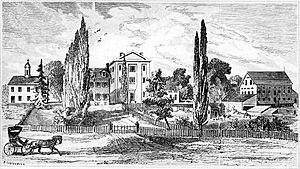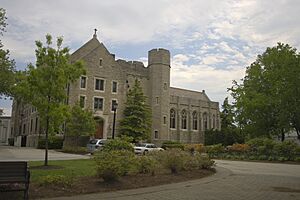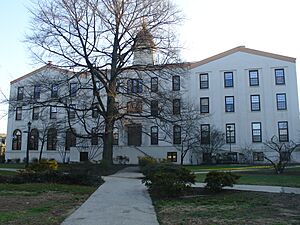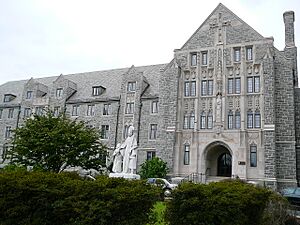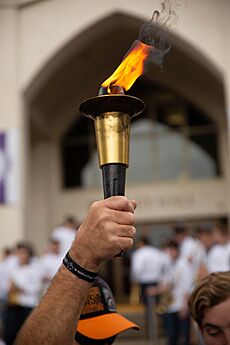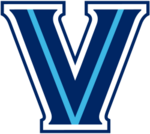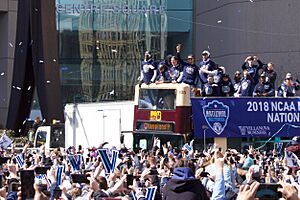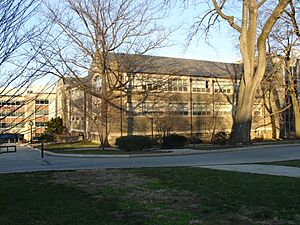Villanova University facts for kids
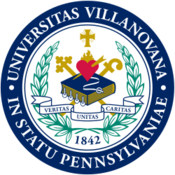 |
|
|
Former names
|
Saint Augustine's Academy (1811–) Augustinian College of Villanova (1842–1953) |
|---|---|
| Motto | Veritas, Unitas, Caritas (Latin) |
|
Motto in English
|
"Truth, Unity, Love" |
| Type | Private research university |
| Established | 1842 |
| Founder | Order of Saint Augustine |
|
Religious affiliation
|
Catholic (Augustinian) |
|
Academic affiliations
|
|
| Endowment | $1.31 billion (2024) |
| President | Peter M. Donohue |
| Undergraduates | 6,791 |
| Postgraduates | 3,108 |
| Location |
,
Pennsylvania
,
United States
40°02′16″N 75°20′15″W / 40.03771°N 75.33755°W |
| Campus | Large suburb, 430 acres (170 ha) |
| Other campuses | Radnor |
| Newspaper | The Villanovan |
| Colors | Blue and white |
| Nickname | Wildcats |
|
Sporting affiliations
|
|
| Mascot | Will D. Cat (current) Count Villan (former) |
 |
|
Villanova University is a private Catholic university in Villanova, Pennsylvania, USA. It was started by a group of Catholic priests called the Augustinians in 1842. The university is named after Saint Thomas of Villanova. It's the oldest Catholic university in Pennsylvania. It's also one of only two Augustinian universities in the USA.
Villanova's story began with Saint Augustine's Church in Philadelphia. Augustinian priests founded this church in 1796. They also had a school, Saint Augustine's Academy, which opened in 1811. Today, Villanova is known as a university with high research activity.
Contents
History of Villanova University
In October 1841, two Augustinian priests from Philadelphia bought 200 acres of land. They wanted to start a school. This land was known as "Belle Air." The school, called "Augustinian College of Villanova," opened in 1842. The Augustinians also helped Catholics living nearby.
However, money problems caused the college to close in February 1845. This happened after riots in Philadelphia burned Saint Augustine's Church. The college reopened in 1846 and its first students graduated in 1847. In 1848, the state of Pennsylvania allowed the school to give out degrees. The school closed again in 1857 due to a need for more priests and money issues. It stayed closed during the Civil War and was used as a military hospital. It reopened in September 1865 and has been open ever since.
Villanova was an all-male school until 1918. That year, women began taking evening classes to become teachers. In 1938, a woman earned a degree from Villanova for the first time. When the nursing school opened in 1953, women started attending full-time. By 1968, Villanova University became fully coeducational, meaning both men and women could attend all programs.
During World War II, Villanova was one of many colleges that helped train Navy officers. Since then, 25 US Naval Admirals and Marine Corps Generals have graduated from Villanova. Only the Naval Academy has produced more.
After World War II, Villanova grew a lot. Many returning soldiers enrolled, and the number of teachers quadrupled. New buildings were constructed. In 1953, the College of Nursing and the School of Law were started. Villanova officially became a university on November 18, 1953.
In 2023, Villanova University announced that Cabrini University would join Villanova in 2024. In March 2025, Rosemont College and Villanova University announced they would merge by 2027.
Exploring the Campus
Villanova University is located in Villanova, Pennsylvania. The campus, including the new Cabrini and Rosemont campuses, covers 430 acres. It is about 12 miles from downtown Philadelphia. The campus has around 1,500 trees.
Main Campus Highlights
The most famous building on campus is St. Thomas of Villanova Church. Its two tall spires are the highest points at the university. Construction on the church began in 1883 and finished in 1887.
Alumni Hall is one of the oldest buildings on campus, dating back to 1848. It was used as a military hospital during wartime. It also helped influenza patients after World War I.
Falvey Library is the main research library on campus. It holds over 1 million books and thousands of magazines. It also has television production studios.
Academics and Rankings
Villanova spent $26 million on research in 2022. This ranked it 264th in the nation for research and development.
| USNWR National University | 58 |
|---|---|
| Washington Monthly National University | 108 |
| Forbes | 87 |
University Rankings Explained
In 2016, Villanova was classified as a "Doctoral University: High Research Activity." This means it offers many doctoral programs. Because of this, U.S. News & World Report included Villanova in its "National Universities" rankings for the first time in fall 2016.
For over ten years, U.S. News & World Report ranked Villanova as No. 1 in the "Best Masters Universities" category for the Northern Region. This ranking was for schools with undergraduate and master's programs, but few doctoral programs. In 2016, Villanova was also ranked second for "Best Value Schools" and fourth for "Best Undergraduate Teaching" in that category.
In 2025, U.S. News & World Report ranked Villanova as tied for the 58th best National University in the U.S. It was also ranked the 69th Best Value School.
The Villanova School of Business was ranked No. 1 in the U.S. by Bloomberg Businessweek in 2016. However, Bloomberg no longer ranks undergraduate business schools after 2016.
The Villanova University School of Law was ranked tied for 65th among all U.S. law schools in 2019.
How to Apply to Villanova
Admission to Villanova is considered "most selective." The university offers three ways to apply:
- Early Decision (a binding choice)
- Early Action
- Regular Decision
For fall 2023, Villanova received 23,721 applications from high school students. About 4,870 students were accepted, which is about 21%. The average GPA for admitted students was between 4.20 and 4.58. Their SAT scores were typically between 1450 and 1520. ACT scores were usually between 33 and 35.
Student Life and Activities
| Race and ethnicity | Total | ||
|---|---|---|---|
| White | 72% |
|
|
| Hispanic | 9% |
|
|
| Asian | 6% |
|
|
| Black | 5% |
|
|
| Other | 4% |
|
|
| Foreign national | 2% |
|
|
| Economic diversity | |||
| Low-income | 10% |
|
|
| Affluent | 90% |
|
|
Villanova students can join many different groups. These include sports clubs, cultural organizations, and Greek-letter groups. Students also take part in many charity and volunteer activities. One of the biggest is the student-run Special Olympics event.
Helping Others: Charity and Service
As a Catholic Augustinian school, Villanova has an active Campus Ministry.
The annual Special Olympics Fall Festival at Villanova is the largest student-run Special Olympics event in the world. It brings together over 1,000 athletes and 400 coaches from Pennsylvania. Students volunteer to plan this event for over nine months.
Villanova University also holds an annual NOVAdance. This is a year-long fundraising effort that ends with a 12-hour dance marathon each spring. It raises money for the Andrew McDonough B+ (Be Positive) Foundation. NOVAdance started in 2014 and is now a yearly event.
Villanova students are also known for their involvement with Habitat for Humanity. In 2004, Villanova had more students participate in the Habitat for Humanity Collegiate Challenge than any other U.S. university.
The School of Engineering has a student chapter of Engineers Without Borders. This group helps improve living conditions in communities around the world. Their first project was building a playground in New Orleans after Hurricane Katrina.
The Blue Key Society is a group of about 200 student volunteers. They work with the Admissions Office to give tours of the campus to visitors.
Student Government and Groups
The Student Government Association (SGA) was founded in 1925. It has three parts: the Executive Branch, the Senate, and the Judicial Council. Students lead all parts of the SGA.
About 30% of Villanova students are part of fraternities or sororities. There are no fraternity or sorority houses on campus. The first Greek organization at the school started in 1902.
Villanova Emergency Medical Service (VEMS)
Villanova Emergency Medical Service (VEMS) is a student-run ambulance service. It is licensed to serve the campus community. VEMS has over 40 student volunteers. Most of them are certified as Emergency Medical Technicians. They volunteer over 25,000 hours each year. Villanova is one of only a few colleges that provides EMS services to its campus.
Campus News and Media
The Villanovan is the official student newspaper. It has been recognized since it started in 1916. It usually publishes 12 issues per semester.
The Belle Air Yearbook is the university's official yearbook. Students have created it since 1922. The yearbook has won many awards over the years.
VTV is the student-run campus television station. It started in 1999. The station produces news, event coverage, films, and other shows for the Villanova community.
WXVU is the student-operated FM radio station. It broadcasts at 89.1 megahertz. WXVU can be heard around campus and online. It offers a variety of music, news, sports, and other programs.
POLIS Literary Magazine is a student publication. It is printed once a semester. It features writing and artwork by Villanova students and professors.
Since 1946, the NROTC program on campus has trained many leaders. It has produced 25 Admirals and Generals for the United States Navy and Marine Corps. In 2004, the commanders of both U.S. Naval Forces Atlantic and U.S. Naval Forces Pacific were Villanova NROTC graduates.
Student Performing Arts
Villanova University does not have a formal music department. Instead, the Office of Student Performing Arts organizes student groups. Nearly 10% of students are involved in music groups.
The Villanova Band is the largest and oldest music group at Villanova. It has over 100 members. The band has four parts: Concert Band, Scramble Band, Pep Band, and Jazz Ensemble. They perform at concerts, football games, and basketball games.
The Pastoral Musicians are the second-largest music group. They have about 60 singers and 35 musicians. They perform different styles of Catholic music.
The Villanova Singers are the men's chorus. They were founded in 1953. They sing many types of music, from classical to modern. A smaller a cappella group within the Singers is called the Spires. Famous alumni of the Spires include Jim Croce and Tim Hauser from The Manhattan Transfer.
The Villanova Voices are the women's chorus. They are the oldest women's organization at the university. They were founded in 1960. Their a cappella group is called the Haveners.
Sports at Villanova
Villanova University sports teams are called the Wildcats. They compete in NCAA Division I. Most teams play in the Big East Conference. The football and rowing teams compete in the Colonial Athletic Association. The women's lacrosse team plays in the Patriot League.
The Wildcats are also part of the Philadelphia Big 5. This is a group of traditional basketball rivalries in the Philadelphia area. Their biggest rival is Saint Joseph's University, and games between them are called the "Holy War".
In 2020, Villanova had a very high graduation rate for its athletes, at 97 percent. Twelve of its athletic programs had a perfect 100 percent graduation rate.
Men's Basketball Success
In 1985, the men's basketball team won the NCAA Division I men's basketball tournament. This was a big upset, as they beat the defending champions, Georgetown.
In 2016, the Wildcats won the 2016 NCAA Championship. They defeated North Carolina 77–74. The game ended with a buzzer-beater shot by Kris Jenkins, which is rare in championship games.
In 2018, Villanova won the 2018 NCAA Championship by beating the Michigan Wolverines 79–62. Donte Divincenzo, a player who came off the bench, scored 31 points. He was named the Final Four MVP.
The Wildcats play their home games at the 6,500-seat Finneran Pavilion on campus. They also play larger games at the 20,478-seat Wells Fargo Center in Philadelphia.
Football Team
The Villanova men's football team plays in the NCAA Football Championship Subdivision. They are part of the Coastal Athletic Association Football Conference.
Some sources say that the 1906 Villanova team was the first to complete a legal forward pass in football history.
Men's Lacrosse
The Villanova men's lacrosse team competes in NCAA Division I as part of the Big East Conference. In 2009, Villanova won the Colonial Athletic Association tournament. This was their first title and led to their first NCAA tournament appearance.
Track and Field Achievements
Villanova University's track and field team has a long history of success. They have won many Big East Conference and NCAA Championships.
The men's team has won 69 NCAA Championships (36 Indoor and 33 Outdoor). They have also won eight NCAA team Championships. Twenty-eight Villanova athletes have competed in the Olympics. Ten of them have won medals, including seven gold medals. The men's team has won 112 Penn Relay Championships, which is the most wins by any school.
The women's team has also been very successful. They have won 11 Big East team Championships and nine NCAA team Championships. They won the 2009 and 2010 NCAA Cross Country Championships. Nine women Olympians have come from Villanova. The Women's team has won 28 Penn Relay Championships, the most by any women's team.
At least one Villanova athlete has competed in every Summer Olympics since 1948. They have won a total of 13 medals (nine gold, four silver).
Villanova Traditions
The University Seal
The seal of Villanova University is based on the seal of the Augustinian Order. It is seen everywhere on campus. A ribbon on the seal has the university motto: Veritas, Unitas, Caritas. This means "Truth, Unity, Love." These are important values for everyone at Villanova.
A book on the seal represents Saint Augustine's love for education. A cincture is part of the clothing worn by Augustinian priests. A flaming heart shows Augustine's search for God and his love for others. A crosier, a staff carried by a bishop, honors Augustine's role as a bishop. Two crosses symbolize Augustine's conversion to Christianity and the university's Catholic faith. A laurel wreath around the seal means victory through learning. The year 1842 is when the university was founded.
Liberty Bell's "Sister Bell"
Villanova University was once home to the Liberty Bell's "Sister Bell." This bell was made to replace the original Liberty Bell after it cracked. The Sister Bell was installed at the Pennsylvania State House (now Independence Hall). It rang the hours until the late 1820s.
Later, the bell was loaned to the Olde St. Augustine Church in Philadelphia. In 1844, the church and the bell were destroyed during riots. The Augustinian priests had the "Sister Bell" recast. They then brought it to Villanova University. The bell was moved off campus in 2011.
Today, the Sister Bell is kept in the Heritage Room. This room is in the basement of the St. Thomas of Villanova Monastery on campus.
Famous Villanova Alumni
Many notable people have graduated from Villanova University. They include leaders in religion, entertainment, sports, politics, and business.
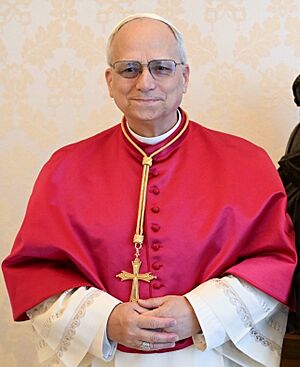
Pope Leo XIV, the first and only American-born pope, graduated from Villanova in 1977. This makes Villanova the only American university with a pope among its alumni. Other important Catholic leaders include John Joseph O'Connor, a Cardinal Archbishop.
In entertainment, famous alumni include actress Maria Bello, news anchor Keith Jones, actor Jon Polito, and singer-songwriters Jim Croce and Don McLean.
Professional athletes from Villanova include NFL Hall of Famer Howie Long, NBA players Kyle Lowry and Jalen Brunson.
Villanova has also produced many government officials. These include former Pennsylvania Governor Ed Rendell and former New Hampshire Governor Kelly Ayotte.
Many Marine generals and Navy admirals graduated from Villanova's Naval ROTC program. These include William J. Fallon, an Admiral in the U.S. Navy, and Paul X. Kelley, who was the Commandant of the United States Marine Corps. Joe Clancy, former Director of the United States Secret Service, is also an alumnus.
In business, alumni include John Drosdick, former CEO of Sunoco, and Thomas G. Labrecque, former chairman and CEO of Chase Manhattan Bank.
See also
 In Spanish: Universidad Villanova para niños
In Spanish: Universidad Villanova para niños
- Education in Philadelphia
- Roman Catholicism in the United States


